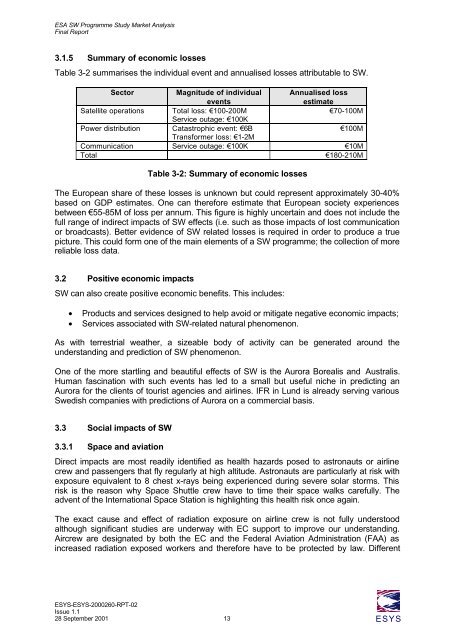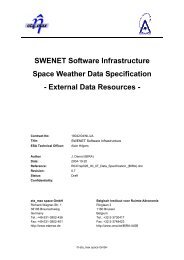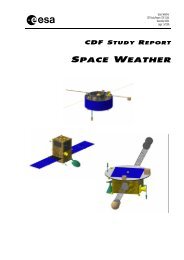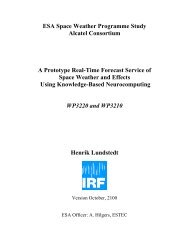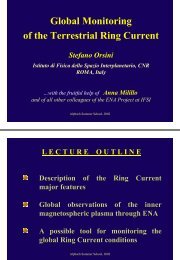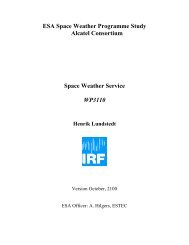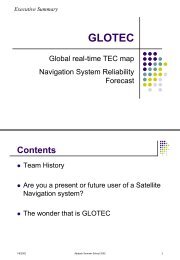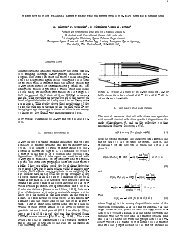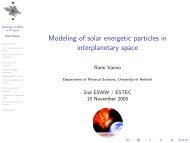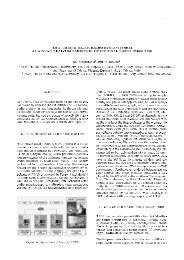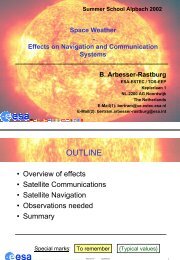market analysis final report v1.1 - ESA Space Weather Web Server
market analysis final report v1.1 - ESA Space Weather Web Server
market analysis final report v1.1 - ESA Space Weather Web Server
Create successful ePaper yourself
Turn your PDF publications into a flip-book with our unique Google optimized e-Paper software.
<strong>ESA</strong> SW Programme Study Market Analysis<br />
Final Report<br />
3.1.5 Summary of economic losses<br />
Table 3-2 summarises the individual event and annualised losses attributable to SW.<br />
Sector Magnitude of individual Annualised loss<br />
events<br />
estimate<br />
Satellite operations Total loss: €100-200M<br />
Service outage: €100K<br />
€70-100M<br />
Power distribution Catastrophic event: €6B<br />
Transformer loss: €1-2M<br />
€100M<br />
Communication Service outage: €100K €10M<br />
Total €180-210M<br />
Table 3-2: Summary of economic losses<br />
The European share of these losses is unknown but could represent approximately 30-40%<br />
based on GDP estimates. One can therefore estimate that European society experiences<br />
between €55-85M of loss per annum. This figure is highly uncertain and does not include the<br />
full range of indirect impacts of SW effects (i.e. such as those impacts of lost communication<br />
or broadcasts). Better evidence of SW related losses is required in order to produce a true<br />
picture. This could form one of the main elements of a SW programme; the collection of more<br />
reliable loss data.<br />
3.2 Positive economic impacts<br />
SW can also create positive economic benefits. This includes:<br />
• Products and services designed to help avoid or mitigate negative economic impacts;<br />
• Services associated with SW-related natural phenomenon.<br />
As with terrestrial weather, a sizeable body of activity can be generated around the<br />
understanding and prediction of SW phenomenon.<br />
One of the more startling and beautiful effects of SW is the Aurora Borealis and Australis.<br />
Human fascination with such events has led to a small but useful niche in predicting an<br />
Aurora for the clients of tourist agencies and airlines. IFR in Lund is already serving various<br />
Swedish companies with predictions of Aurora on a commercial basis.<br />
3.3 Social impacts of SW<br />
3.3.1 <strong>Space</strong> and aviation<br />
Direct impacts are most readily identified as health hazards posed to astronauts or airline<br />
crew and passengers that fly regularly at high altitude. Astronauts are particularly at risk with<br />
exposure equivalent to 8 chest x-rays being experienced during severe solar storms. This<br />
risk is the reason why <strong>Space</strong> Shuttle crew have to time their space walks carefully. The<br />
advent of the International <strong>Space</strong> Station is highlighting this health risk once again.<br />
The exact cause and effect of radiation exposure on airline crew is not fully understood<br />
although significant studies are underway with EC support to improve our understanding.<br />
Aircrew are designated by both the EC and the Federal Aviation Administration (FAA) as<br />
increased radiation exposed workers and therefore have to be protected by law. Different<br />
ESYS-ESYS-2000260-RPT-02<br />
Issue 1.1<br />
28 September 2001 13 ESYS


